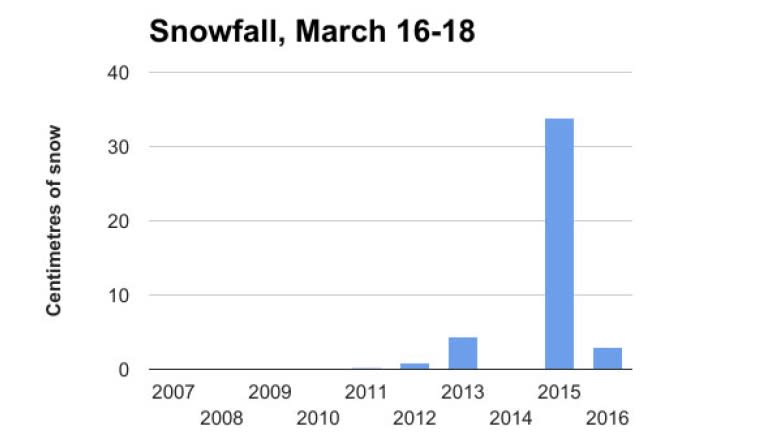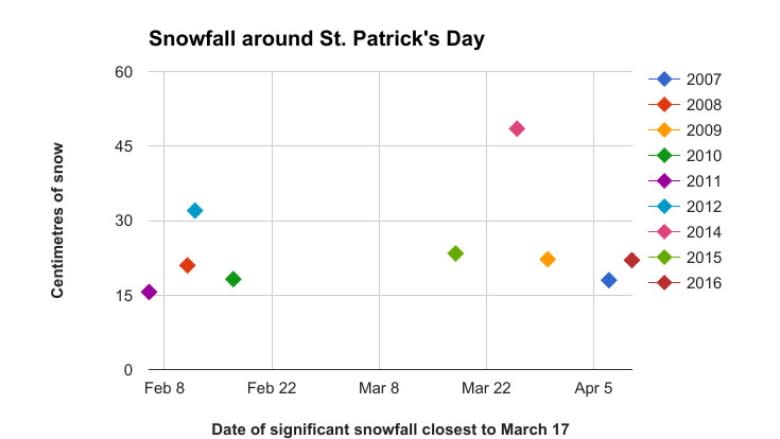No St. Patrick's Day storm? Don't be surprised
It looks like 2017 will put another nail in the coffin of the P.E.I. myth of the St. Patrick's Day storm.
There are currently only flurries in the forecast for Thursday through Saturday, but still the refrain rings around the Island every March, particularly if the weather is mild at the beginning of the month. It may be nice now, but wait for St. Patrick's Day. It always storms around St. Patrick's Day.
Does it?
Well, no. It doesn't. Looking back over the last decade, it would appear that, if anything, snow avoids St. Patrick's Day.
During the decade from 2007 to 2016 only once has a significant amount of snow fallen from March 16-18, on St. Patrick's Day and the days on either side of it. That was during the Snowmageddon of 2015, when storms hit on both March 16 and 18.
It is worth noting, however, that only a trace of snow fell during St. Patrick's Day itself. This in a month when there was measurable snowfall on 16 of 31 days.
Even with that big dump in 2015, the snowfall for those three days over the last decade is slightly below average for March.
- March average for three days: 4.26 cm
- Average for March 16-18: 4.22 cm
But there's always a storm somewhere around the day, right?
Nope.
If you look at snowfalls in excess of 15 centimetres in a single day, you don't find many close to St. Patrick's Day in the last decade.
There are, in the last 10 years, records of only three Marches where there were days when more than 15 centimetres of snow came down. The records for March 2013 are spotty, so there might have been something there.
But to put that another way, in six of the last 10 years there has not been a significant snowfall day in all of March.
How did this get to be a thing?
I checked with three P.E.I. historians, and none of them had any strong ideas about the roots of this bit of Island folklore.
There is a similar folklore in Newfoundland, where the storm is known as Sheila's Brush. The tradition is a little different, connected with the belief that the weather is unsafe and unpredictable until the first storm after St. Patrick's Day, which may be true enough in Newfoundland.
UPEI professor Ed MacDonald makes reference to concerns about volatile late winter, early spring weather for a possible explanation. For farming communities, late storms could be hard on sheep, which were sheared in the spring.
"Even though sheep were never a major livestock on P.E.I., our cultural baggage comes from the U.K., and I wouldn't be surprised if folk wisdom carried to P.E.I. a wariness about late winter/early spring storms," said MacDonald.
Historian Dutch Thompson points out St. Patrick's Day is a traditionally a day for country folk to travel into towns for concerts. This might have made any storm day stick in people's minds, or perhaps, said Thompson, it was wishful thinking for people hoping to be stormstayed for another day away from the farm.
Not even in 1928 or 1938
The last 10 years do not stand alone in their lack of St. Patrick's Day storms.
David Weale is also at a loss to explain the origins of the folklore, but when I asked him he did a little research of his own.
"Just for fun checked two old P.E.I. diaries for the years 1928 to 1938, one from Irishtown and one from Freetown," Weale wrote.
"In that decade neither of the authors, Andrew MacLeod or John Scott Cairns, mentioned a storm on St. Patrick's Day."
- MORE P.E.I. NEWS | Projected P.E.I. deficit almost doubles
- MORE P.E.I. NEWS | P.E.I. government steps in to advise Murray Harbour village council




